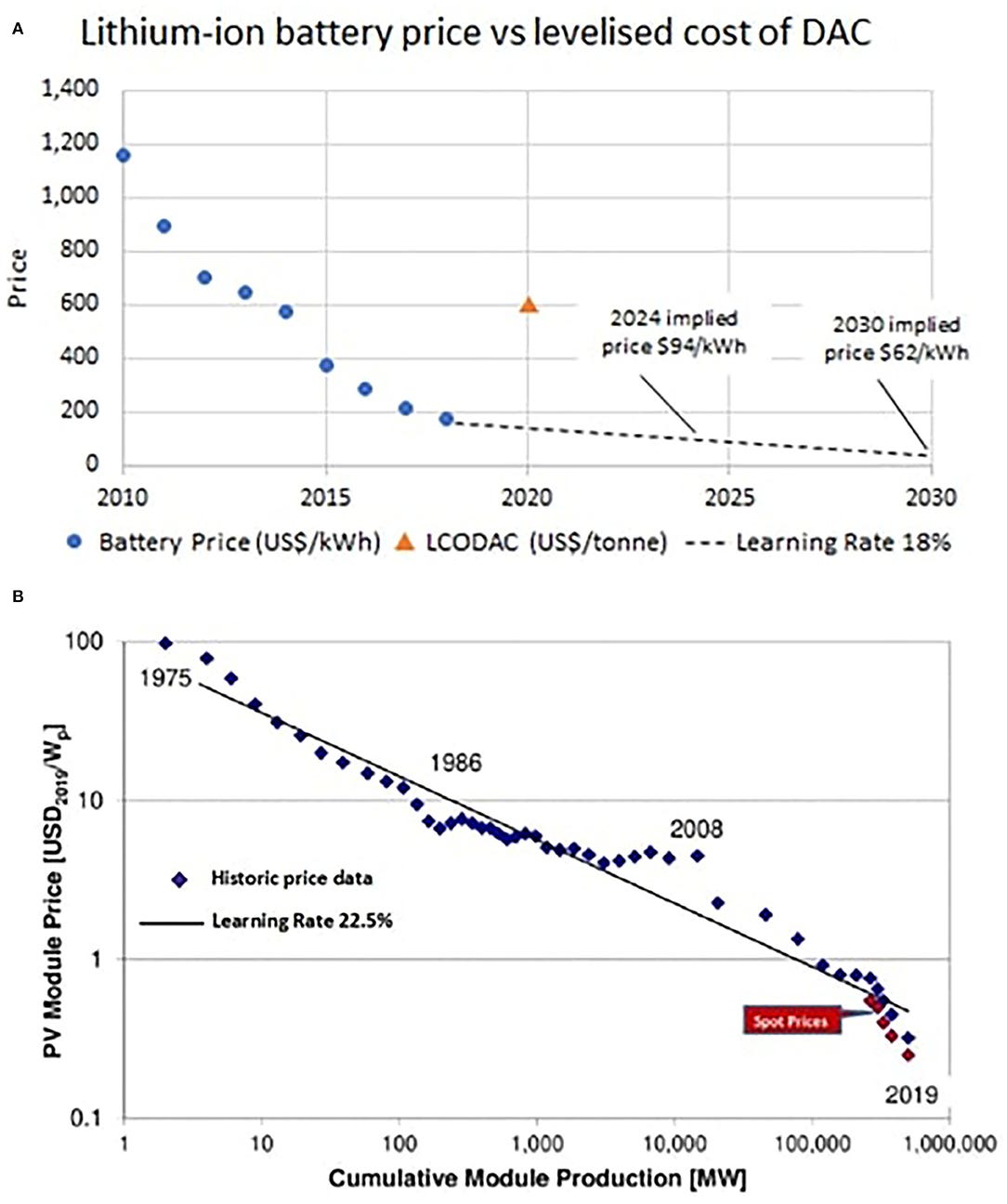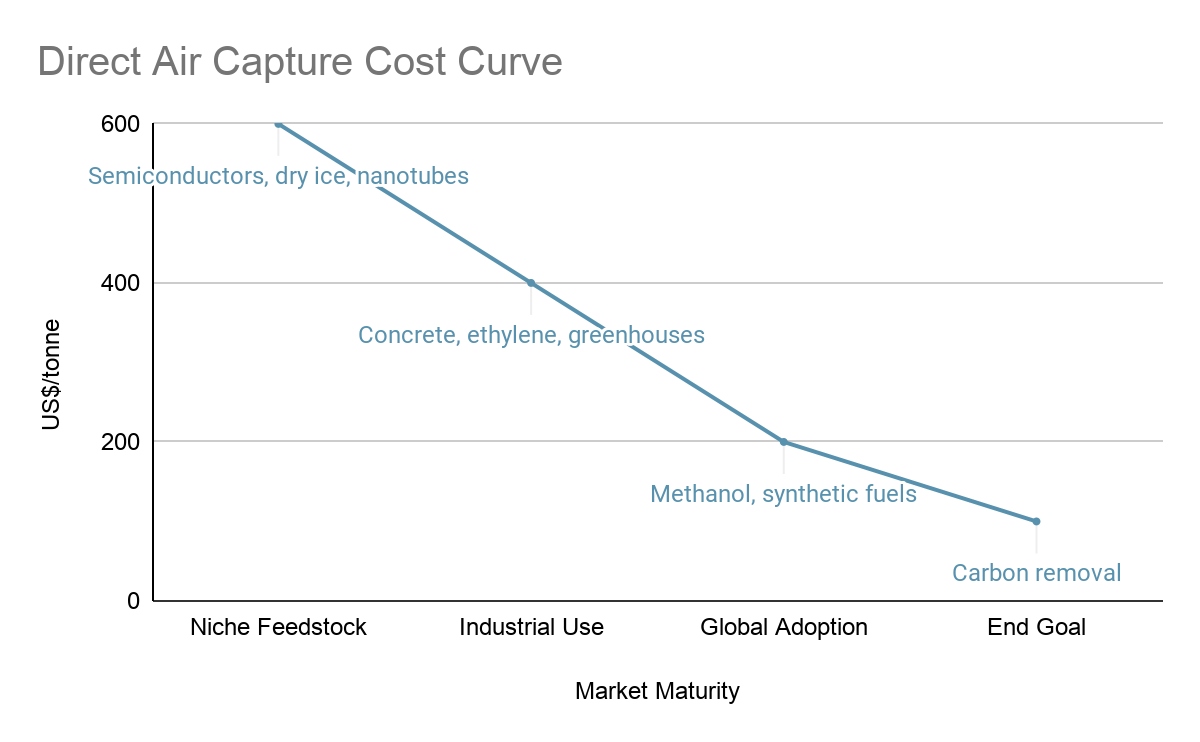Part 2: Lessons from the laws. What learning we can apply to the development of modular direct air capture from recent history of energy technology innovation
Modular direct air capture shares some potentially important characteristics with the likes of solar PV and lithium-ion batteries and we could well see a similarly unanticipated cost-curve trajectory
The first post of this series set the scene for this five part extravaganza offering a breakdown of my first peer-reviewed article, and what I believe are three much underdiscussed aspects of what it will take to scale up modular direct air capture (DAC) technology to a gigatonne scale by mid-century. This piece will offer a deep dive into the potential benefits we can accrue from peeking back in time a few decades, and look at what lessons we can adopt for modular DAC technology from recent experience and history of scaling up tangential energy technologies.
It turns out a lot of my thinking on this topic is not all that original. By coincidence, on the same day I submitted the article, Max Roser of Our World in Data published a fantastic piece on why renewables got so cheap so fast. This article led me to the work of Professor Gregory Nemet who has published a book focused on the same theme, titled ‘How Solar Became Cheap’, but crucially asks a different question - why did it take so long? - nearly seven decades from the breakthroughs at Bell Labs in 1954. More recently, I also discovered one of the most famous modern day investors and an individual likely familiar to the tech bro’s out there - Cathie Wood of Ark Invest, frequently cites a particular technological observation, Wright’s law, as a foundational thesis of some of her firms’ investment decisions.
“Quantifiable technological progress has been recorded for decades, if not centuries. The most well-known is arguably Moore's law, documenting that the capacity of transistors on microprocessors doubles every 2 years. More recently, Swanson's law observes that for every doubling of cumulative production volume, the price of solar PV modules declines by 20% (Figure 1B). Both are grounded in lessons from the lesser-known Wright's law, outlined in Theodore P. Wright's 1936 paper Factors affecting the costs of airplanes (Wright, 1936). While Moore's law describes technological change as a function of time, and observations for solar are a reflection of experience, Wright's law combines innovation and economies of scale in a “we learn by doing” approach.”
Firstly, the framing of these trends from recent history as ‘laws’ is slightly disingenuous. They more closely reflect observations rather than a constant that is a law, especially considering Moore’s law is supposedly seeing its final days. That said, they can offer valuable lessons for what we could observe for modular direct air capture technologies. Especially so if we take a leaf out of Professor Nemet’s book after considering why solar took so long to become cheap, and ask how solar PV can serve as a model for other technologies like modular DAC. Fortunately for the rest of us, Nemet did such a thing, with variables including: diffusion of scientific knowledge across borders, mass production, modular scale, siutability in niches, and opportunities for technology spillovers, all potentially contributing to an accelerated deployment pathway of modular DAC using these observations and nearly seven decades of solar PV experience.
Although Moore’s is the most widely known among the respective laws, the experience of semiconductors is likely the least applicable to modular DAC given that it is largely centred around physics. As predicted by Gordon Moore, shrinking transistors actually made semiconductors progressively more powerful and efficient, resulting in regular decreases in computing costs per unit with near constant manufacturing costs. While there are thermodynamic and sorbent performance gains to be made in DAC technology, these will be more products of advanced engineering and chemistry than the laws of physics. In contrast, the recent experience of solar PV and lithium-ion battery manufacturing and consequent cost declines, facilitated by characteristics of Wright’s law, is likely more pronounced for modular direct air capture.
The comparatively scantly mentioned Wright’s law provides the foundation for what is commonly referred to as a cost or learning curve. What came to be known as Swanson’s law - a solar PV module price decline of 20% for every doubling of cumulative production - builds on the thesis offered by Theodore Wright way back in 1936, outlining a framework to forecast cost declines as a function of cumulative production. As has been observed for solar PV (‘Swanson’s law’), Wright’s law states that for every cumulative doubling of units produced, costs will fall by a constant percentage. This is illustrated in the cost curves below for both lithium-ion batteries and solar PV whose learning rates have coincidentally converged at an impressive and constantly forecast beating ~20%.

While the DAC industry is nascent with far too little by way of deployment to indicate potential experience curve or ‘learning by doing’ effects, the very recent history of lithium-ion batteries provides a good pathway to build on, and shares multiple traits with the experience of solar PV. The underlying technologies of modular DAC, batteries and solar PV are admittedly very different. However, they share plenty of similarities from a deployment perspective - modular scale, applications in niche markets, potential for mass production, and technology spillovers. Much like how the early applications of solar PV were found in niche markets like satellites, off-grid homes, telecommunications and somewhat ironically, offshore oil rigs, the same can be said of lithium-ion batteries and subsequently, modular DAC.
Consumer electronics have historically been the mainstay application for lithium-ion batteries, and their steadily increasing production allowed the battery technology to move down the cost-curve until reaching a critical threshold, enabling its adoption in an entirely different, albeit huge market: passenger electric vehicles. This threshold brought renewed momentum and production at scales unlike anything before it - an average range electric vehicle has as much battery power as 5,000 smartphones. It should therefore be of no surprise that with just 10% of the total ~65 million of annual cars sold possessing a plug, this has sparked the dawn of the (battery) gigafactory age, and with it a rapid decline in time required for further cumulative doubling of production. As per Wright’s law, predictions of price declines for lithium-ion batteries have subsequently followed with this significant increase in deployment, allowing the technology to approach commercial competitiveness for another golden market opportunity: utility-scale energy storage.

The cases of solar PV and lithium-ion batteries are arguably the best examples of modern day Wright’s law at work. Each deployment scenario allowed these modular DAC tangential technologies to benefit from the ‘learning by doing’ effects of Wright’s law; with each additional ‘niche’ use case providing the experience to cross critical price thresholds and crucially, open up new and ultimately bigger, more lucrative markets. While the mass market end-game for modular DAC technology is wide-scale carbon removal, at ~US$600 per tonne of CO2 removal today via DAC, that’s a financial non-starter. Some, or rather many, would rather dismiss it as too expensive - much like they did with solar PV and lithium-ion batteries - and suggest we move on. However, like with solar and batteries, niche applications exist for modular DAC technology to provide the initial deployment and, importantly, the learning to move down the cost-curve and open up additional markets. Alongside early carbon removal purchases from big (North American) tech - to be discussed in Part 3, current niche use cases for DAC-derived ‘green CO2’ include the synthesis of diamonds, vodka, enhancing crop growth in greenhouses, and creating the bubbles in your can of coke.

While the cumulative production of DAC modules needs to number in the millions in just a couple of decades from the hundreds today, the ‘carbon to value’ (carbon utilisation) market likely offers the best pathway to achieve such scale. Marginal premium purchases of DAC-derived carbon removal, while valuable, will not get us to a sufficient scale - at US$400-600/tonne - to benefit from the ‘learning by doing’ effects that we have observed with other technologies exploiting the power of Wright’s law. This is why the (also) nascent carbon utilisation market is often touted as a crucial intermediate step, offering niche markets at scale to faciliate commercial deployment, move down the cost-curve, and over time open up subsequent market applications before the emergence of a viable modular DAC carbon removal market at a climate consequential scale.
Given the direct air capture industry currently has a deployed capacity in the thousands of tonnes, it is by no means a given that it will scale to a giga (billion) tonne scale within three decades - half the time it took solar PV to achieve mass commercial scale. Thankfully, we are not starting from stratch and have a blueprint from the experience of solar and battery technologies. Modular scale, standardised mass production, suitability in niches and opportunities for technology spillovers are all highly applicable to the development of modular DAC technology. It’s incumbent upon DAC practitioners to learn these lessons from recent history of energy technologies and mould modular DAC technology in their image, but a lot faster, if we are to avoid climate catastrophe.
While we can control how the supply-side of the DAC industry develops, we are unable to dictate the evolution of underlying markets (demand) for modular DAC and its ‘green CO2’ product. The next part of this series covers the dynamics at play in the chicken and egg conundrum that is the development of a commercial scale modular DAC industry. For those who haven’t already, subscribe below to receive it directly in your inbox!
To receive David and Goliath’s commentary, analysis and thoughts in your inbox once a week, become a subscriber today!
✓
If you enjoyed this piece, you can share it as a web page by clicking the button below:
If you’ve got useful (and/or interesting) things to say and would like to post a comment, click the “Leave a comment” button:
Stay positive, be kind to those around you, and have a great week ahead!



these stories are so helpful David, thank you!